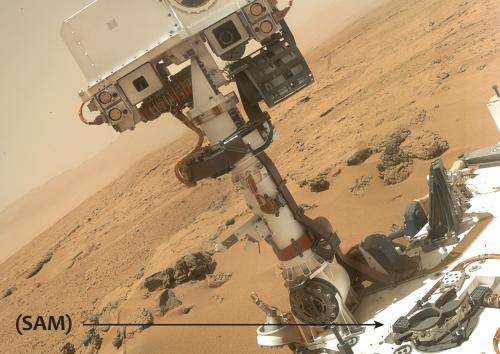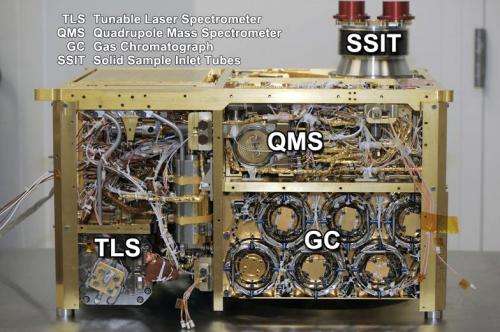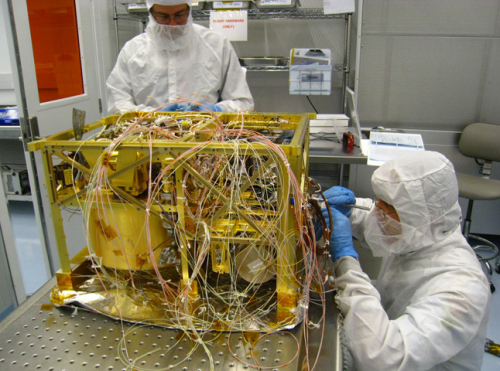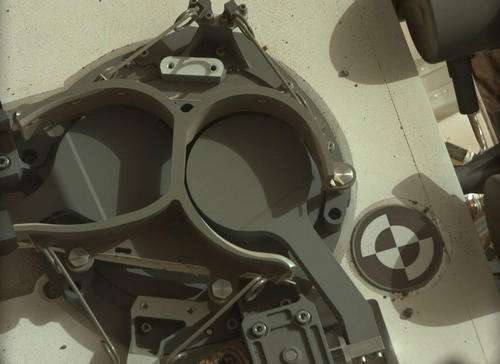I am SAM

Yesterday Mars Science Laboratory principal investigator John Grotzinger set the entire space science world abuzz with a tantalizing promise of "earthshaking" news on the horizon—literally "one for the history books," as he put it in an interview with NPR. It seems one of Curiosity's main science tools, the Sample Analysis at Mars (SAM) instrument, has discovered… something… within recently-gathered samples, possibly in windblown-material scooped at a site called "Rocknest" earlier this month.
For now, though, the MSL team is keeping quiet on any more details until they're reasonably sure they know what they have. Speculations abound—some serious, some not—but the bottom line is we'll all have to wait for the official news to be released. In the meantime, here's your chance to learn a little more about a fascinating high-tech Mars-tasting gadget called SAM.

About the size of a window air conditioning unit, the Sample Analysis at Mars (SAM) instrument is contained within the front section of NASA's Curiosity rover. Actually a suite of three instruments, SAM consists of a Gas Chromatograph (GC), a Quadrupole Mass Spectrometer (QMS), and a Tunable Laser Spectrometer (TLS), as well as systems that manipulate and process samples.
Although mostly contained entirely within Curiosity, SAM does have two small inlet tubes that allow access for soil samples gathered with the rover's arm, as well as inlets for atmospheric gases.
On Earth all of these different instruments would fill a lab. But to fit them all inside the Curiosity, which is about the size of a Mini Cooper (but only half the mass), they were painstakingly reduced in size to fit within a single rectangular structure about 40 kg (88 lbs).

Here's how SAM's components work:
The Gas Chromatograph (GC)
The GC has six complementary chromatographic columns. The GC assembly sorts, measures, and identifies gases it separates from mixtures of gases by pushing the mixed gases through long, coiled tubes with a stream of helium gas. It sorts the gas molecules by weight: they emerge from the tube in order from lightest (out first) to heaviest (out last). Once the gases are sorted, the GC can direct quantities of the separated gases into the QMS or TLS for further analysis.
The Quadrupole Mass Spectrometer (QMS)
The QMS identifies gases by the molecular weight and electrical charge of their ionized states. It fires high-speed electrons at the molecules, breaking them into fragments. It then sorts the fragments by weight with AC and DC electric fields. The spectra generated by the QMS detector uniquely identify the molecules in the gases.
The Tunable Laser Spectrometer (TLS)
The TLS uses absorption of light at specific wavelengths to measure concentrations and isotope ratios of specific chemicals important to life: methane, carbon dioxide, and water vapor. Isotopes are variants of the same element with different atomic weights, and their ratios can provide information about Mars' geologic—and possibly biologic—history.

The QMS and the GC can operate together in a GCMS mode for separation and definitive identification of organic compounds. The TLS obtains precise isotope ratios for C and O in carbon dioxide and measures trace levels of methane and its carbon isotope.
In addition to these three analytical instruments SAM also has mechanical support devices: a sample manipulation system (SMS) and a Chemical Separation and Processing Laboratory (CSPL). The CSPL includes high conductance and micro valves, gas manifolds with heaters and temperature monitors, chemical and mechanical pumps, carrier gas reservoirs and regulators, pressure monitors, pyrolysis ovens, and chemical scrubbers and getters.
The SMS has a wheel of 74 small cups where soil samples gathered by Curiosity's robotic arm are prepared for analysis. 59 are quartz cups that are small ovens which can be heated to very high temperatures to pull gases from the powdered samples. 9 sealed cups are filled with chemical solvents for lower-temperature experiments designed to search for organic compounds. The other 9 cups contain calibration materials.
With this suite of precision tools SAM is specifically designed to search for evidence of a habitable environment on Mars, whether past or present. As it takes up over half of the rover's scientific payload area, you could say that Curiosity itself is specifically designed to carry SAM around Mars (although we won't tell that to the other instruments!)
Knowing only that the "exciting" news from Grotzinger and his team is coming from data gathered by SAM, one could safely assume that it has something to do with a discovery of organic chemistry of some sort… but we'll all have to wait a few more weeks to know for sure. Still, as that is the primary objective of MSL and Curiosity is barely over 100 Martian days into its mission, even the smallest hint of big news has everyone's attention.
"Like any big institution, NASA would love to trumpet a major finding, especially at a time when budget decisions are being made," Joe Palca, NPR article.
"This data is gonna be one for the history books," said Grotzinger. "It's looking really good." (Read more here.)
Find out more about SAM and Curiosity's other instruments here, and check out a quick video overview of SAM below:
The result of an international effort between scientists and engineers, SAM was built and tested at NASA Goddard Space Flight Center in Greenbelt, Maryland. Paul Mahaffy is SAM's Principal Investigator.
Source: Universe Today





















